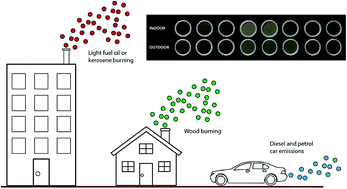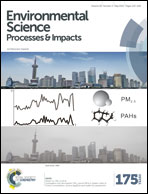Source identification, apportionment and toxicity of indoor and outdoor PM2.5 airborne particulates in a region characterised by wood burning†
Abstract
The occurrence of airborne particulate matter has been flagged as “of concern” in several megacities, especially in Asia. Selected Chilean regions have similar problems as wood burning is the major source of heating in homes. This concern has led to mitigation measures restricting the burning of wood at periods when the particulate matter smaller than 2.5 μm (PM2.5) concentrations are predicted to be high. This work investigates the linkage between indoor and outdoor particle concentrations, determines their source through the polyaromatic hydrocarbon (PAH) signature and investigates the efficacy of the current management practice of burning restrictions. The PM2.5 fraction was collected at 12 different properties with coincident indoor and outdoor sampling using a low-volume active sampler for 24 hours. Indoor concentrations of PM2.5 ranged from 6 to 194 μg m−3 with a mean of 72 μg m−3 and corresponding outdoor concentrations ranged from 5 to 367 μg m−3 with a mean of 85 μg m−3 over the winter periods of 2014 and 2015; the Chilean national permitted maximum in outdoor air is 50 μg m−3 in 24 hours. Higher concentrations were measured when the outdoor air temperature was lower. The PAHs were analysed on the PM2.5 fraction; the indoor concentrations ranged from 2 to 291 ng m−3 with a mean of 51 ng m−3 compared to an outdoor concentration between 3 and 365 ng m−3 with a mean of 71 ng m−3. Multivariate statistical analysis of the PAH profiles using principal components analysis (PCA) and polytopic vector analysis (PVA) identified wood burning, static and mobile diesel emissions and kerosene combustion as the major contributors to the particulate matter. When converted to toxicity equivalents (BaP-TEQ), the highest toxicity arising from PAHs in the indoor air was associated with a property that used a “leaky” combined wood stove and heater and also used a wood-fired brazier for local heating. In outdoor air, there was a relationship between the housing density and the BaP-TEQ, such that denser housing had higher BaP-TEQ values. The restrictions in wood burning on selected days may have had a measureable effect on the PM2.5 concentrations in that region but the effects were small and only present for the day of the restriction.


 Please wait while we load your content...
Please wait while we load your content...